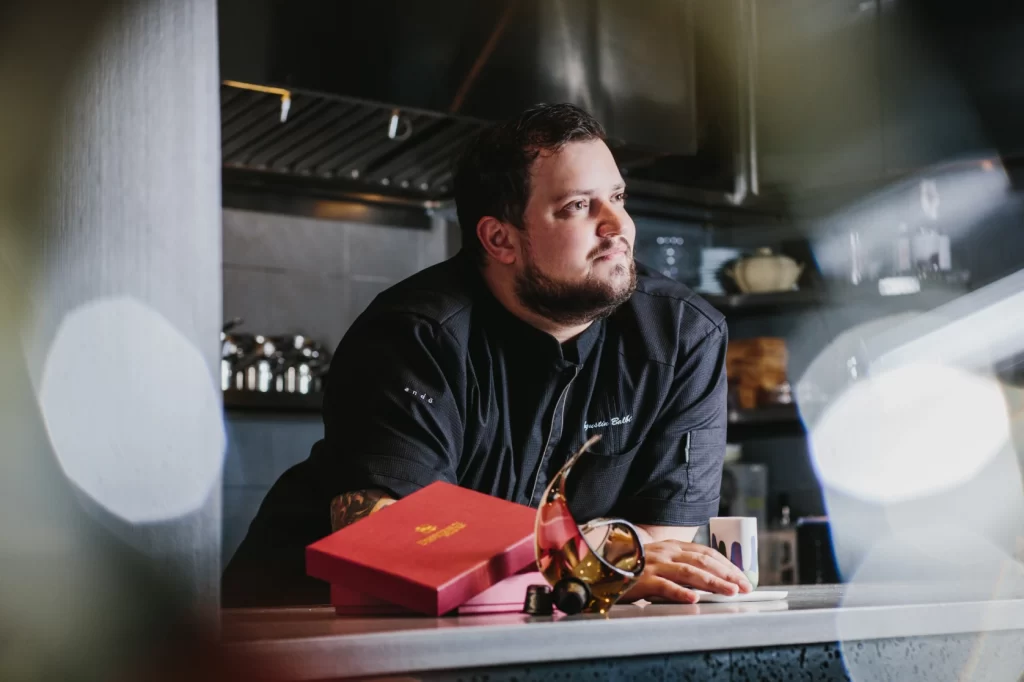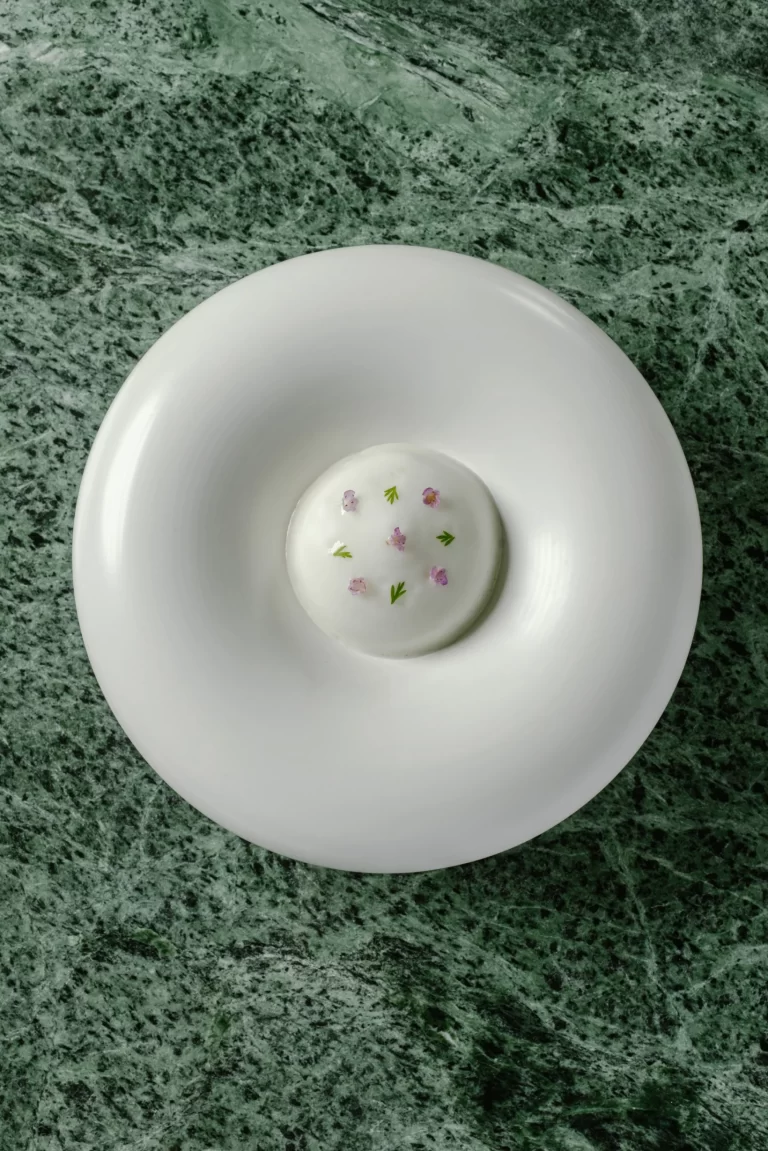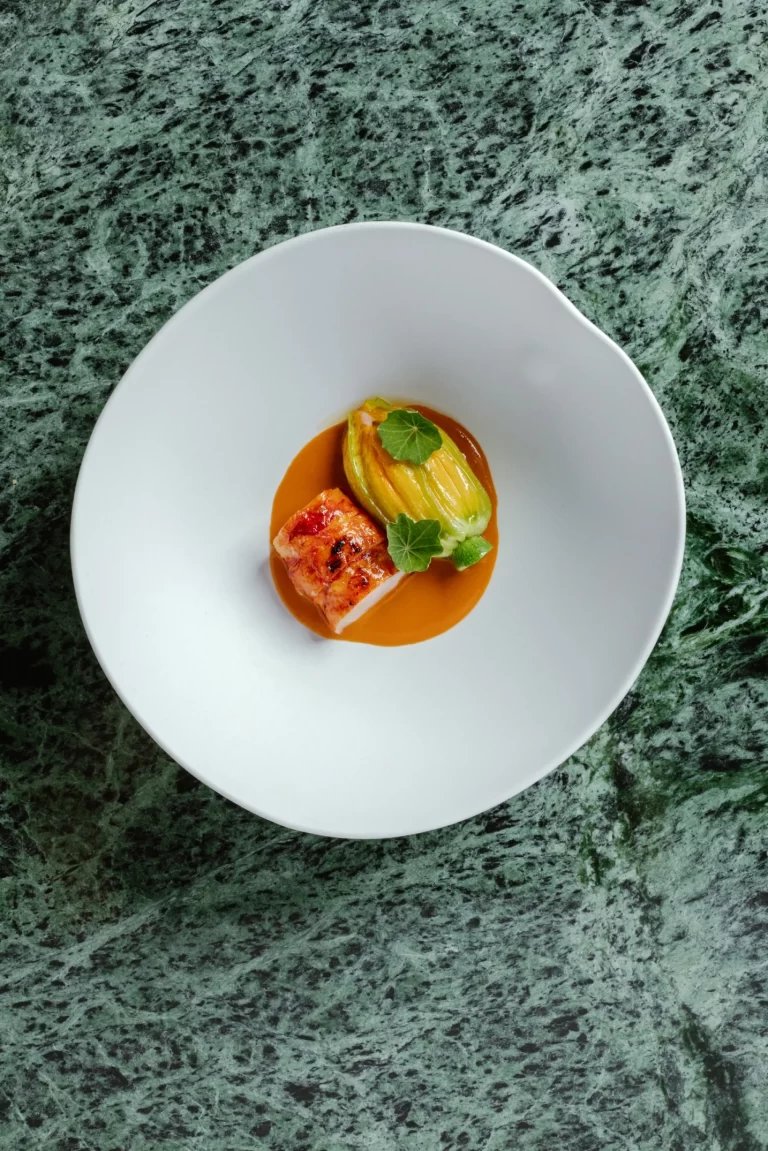With roots in his Spanish-Italian family and guidance from renowned Japenese Chef Hideaki Matsuo, Chef Balbi has crafted a masterclass in fusion cuisine at his Hong Kong restaurant Andō.
With an emphasis on flavour supported by impeccable technique, Chef Balbi’s approach to cooking is sustainable, inventive, and full of gratitude to both his guests and his influences.
With multiple awards, including his Michelin star, La Liste’s Best Young Talent of the World 2019, and a debut at 87 on the list of Best Chefs of the World in 2019, there is little doubt that Chef Balbi’s journey and how he shares that with the world, has only just begun.
Chef Balbi has generously shared his recipes for Tardes en Palermo (French Blue lobster and Kristal caviar with roasted piquillo pepper sauce) and Carabinero Prawn (Wakame Steamed Carabinero Prawn and Duck Egg Yolk Mousse with Salmorejo) with us to help you further your own culinary journey.
We spoke with Chef Balbi about the path his culinary journey has taken over the years.
Why did you choose to pursue a career as a chef?
Looking back today, I can say that I was super lucky to be surrounded by great food at home and also an incredible cook, my grandmother Lola. She was from Mallorca and would always cook the most incredible Spanish food as we ate together watching Karlos Arguiñano on TV (a very famous Spanish chef). I think that was the moment the seed was planted in me.
I started by pure luck; one summer break, when I was 15, I had nothing to do and my mom told me about a friend looking for people to help with his restaurant so I went.
I loved it. I can still clearly see Chef Macarena standing there butchering a big piece of meat; an impeccable white uniform and giving orders to her team while she was doing two or three things. I was mesmerized, and then lunch service started. The adrenaline rush and teamwork made me fall in love with the kitchen, and even then, I started to think that it could be something to dedicate my life to.
What experiences in particular do you feel have advanced you the most as a professional?
Without a doubt, my time in Japan was a before-and-after moment in my career. I spent many years there immersed in a totally different culture to mine, one that is really obsessed with great food.
This allowed me to improve so much, not only at a skill level but also culturally. I started looking at cooking not just as a professional but also as an artisan; a way of life dedicated to making people happy. It gave me the mental and spiritual strength to pursue this career and led to my understanding of how this beautiful profession can, when working with nature, have the power to transform ingredients into something magical.
What chef do you think best represents the culinary arts and why?
There are chefs I admire of course and peers who push me to become better, not competitively but in a way that inspires me to become a better artisan.
Hong Kong and Asia, in general, have incredible chefs with deeply rooted histories and customs. Without a doubt, for me, Kaiseki chefs such as Yamamoto from Ryugin, and Hideaki Matsuo from Kashiwaya are mentors. Even if our cooking styles are very different their philosophy is something I admire deeply.
What professional and personal experiences drive you forward in your career and push your cuisine style?
I enjoy most the interaction with my guests and seeing them truly happy because, at the end of the day, this is our main job: to make people happy. For me, cooking is not a job. If you ask me, I don’t “work” a day in my life. For me, this is a way of living; I am always here training myself to evolve and reach a new level of my craft.
It is beautiful to think that we are one of the only professions to work so closely with nature and to, with our own hands, transform a bunch of simple ingredients into something magical. It is almost like we have the power to give produce a second life with our expertise. This, for me, is something very special and drives me forward every day with new ideas and ways to respect and showcase nature.
Everything inspires me, every experience I have, every place I visit, and every encounter I have; I am always thinking about food and how to elevate my craft. I think it is safe to say I am obsessed with my craft in the most positive way you can imagine.
What, or who, would you say has inspired your cooking the most? What new food influences have you been experimenting with and are they reflected in your work?
Andō is a realization of my own journey as a Chef which is the biggest inspiration in my cuisine combined with my time in Japan. These two are the pillars of Andō cuisine.
We are always looking at tradition as a way of inspiration and thinking about how we can re-imagine [the classic] into something modern and in our own style. We innovate, but this is always based on tradition and follows the most basic, sometimes forgotten when eclipsed by technique, restaurant rule: Flavour is King. This is always our starting point and final point as well. We don’t want trends or techniques to be above flavour. After all, people will come back to your restaurant if the food is delicious.
What do you find most challenging about being a chef? How do you deal with the challenges faced both in your kitchen and in the industry as a whole?
Because this craft is very personal and becomes part of your life, it can be the most beautiful but also the most challenging as it absorbs all of your time. For example, I am happily married to my Japanese wife and I have two kids and it is very challenging to separate the time we spend together.
I am incredibly lucky that my wife understands and supports me in this crazy path, but I don’t take holidays; If I’m not in the restaurant, we don’t open. It is really a life dedicated to the craft of cooking, and it is not easy but is necessary for me to do. Maybe as I grow older that might change but so far I am happy like this.
Also, we live upside down; we work when people have fun, and we have fun when other people work, our schedules are mostly opposite to the norm, and that is another challenge to overcome.
Now a new challenge we need to be really concerned about is the lack of staff available to work in this industry and is something that, as a whole, we need to focus on resolving. If not, the future of restaurants will not be very bright. We need to rethink the restaurant model we know and make it more attractive for future generations to pursue a career in this beautiful field.
What changes have you witnessed on the local and global food scene in recent years?
One thing that is very noticeable is the lack of staff locally and worldwide and that is very alarming. If fewer people are interested in working in restaurants that means that something has to change.
I think the “old school” model of running a restaurant has to be reviewed. Maybe the way we are operating restaurants is not in line with the times we live in.
How would you describe your culinary style? What moments make it memorable?
I think the most memorable moment is the process itself; the deep search for the evolution of my own distinctive style. I try not to look at dishes on social media or books or what kind of dishes other chefs are making; I try to focus on my own path and style.
My style is very distinctive, heavily inspired by my Japanese experience without being Japanese with innovation from my experience in Western cooking, focusing on cultural traditions to bring them into modern days but totally reimagined.
What would you say is the main course of Andō menu? How does this course reflect the identity of the restaurant?
Without a doubt, our signature dish is Sin Lola (without Lola). My grandmother, Lola, always cooked from the heart, with the only goal of seeing me happy. I strive every day to replicate that at Andō. As simple as it sounds, it takes unreasonable hospitality to do.
The main dish is a caldoso rice (soupy rice) dish, a traditional Spanish dish that she used to cook for me. When she made this dish, I was the happiest kid in the world, and I still cook it with that spirit and those memories in mind.
At Andō, it is the only dish that has been on the menu from day one and also the only dish we don’t change. The other dishes are replaced very often but this one no. It is also the only dish where we will ask the guests if they want more, as a grandmother will do, just to make them happy.
What do you think is special or makes the restaurant stand out from similar restaurants?
I think it is the overall package and the omotenashi (wholeheartedly look after guests) spirit we live and create for the team. We don’t only focus on the cooking or service; we fully focus on making people really happy and doing everything we can to make that happen, be it an extra glass of wine or giving an extra portion of the rice dish, or even buying flowers for a birthday or special celebration. We look at every little detail of the overall experience, not only the food, and that makes the restaurant truly feel like a home where you know you are going to be treated as a friend.
We base our work on three very important pillars: anticipating guest needs, attention to detail, and genuine gratitude.
Anticipating our guest’s needs helps put us in their shoes [and understand] what they may need.
Attention to detail goes to every aspect, from how we fold the napkin to how we plate the chives in one dish. This helps us be 100% present at the moment.
Genuine gratitude helps us understand that every single client who comes to Andō also has a choice to go to any other restaurant. They choose to dine with us, so it is our maximum responsibility to do our 100% best and be grateful they choose to eat with us.
Why would guests choose your restaurant over others and how does this influence decision-making in the kitchen going forward?
I think it is related to the previous answer where they know they will get quality, they will be treated like a friend, and also, importantly, the value for money is great – they know they will not leave the restaurant feeling hungry.
Another aspect I think is important is that my cuisine is light. You can be full but without feeling that you need a siesta.
What are a few of your current favorite dishes on the menu, and why?
Of course, without a doubt, for taste and personal story, the closest dish to me will always be the caldoso rice. It is something I really treasure but is also really delicious. It also delivers a sense of comfort and generosity only to be found at a loved one’s home – someone who really cares about you.
I also really like the Fish course: a Suzuki cooked on the bone with a very crispy skin but soft meat with lily bulb and razor clams sauce made with Oba Shiso and urui leaf. The flavour is very well balanced between acidity, fat, and umami levels.
At the end of the day, it is about finding a balance between what you want to do and what people around you want to eat. Ignoring this [will make you] fail. After all, you don’t cook for your ego, you cook to make people happy.
ABOVE: Chef Balbi is active in Hong Kong’s More Good campaign. More Good is an organisation that works to provide high-quality meals to those in need, with an emphasis on nutrition and community.
For more information or to make a reservation go to Andō:
1F Somptueux Central
52, Wellington Street, Central
Hong Kong
WhatsApp (text message only)
(852) 9161 8697
Email – info@andohk.com












